Estimate the likelihood of a snow day with our easy-to-use Snow Day Calculator. Plan ahead and stay informed about potential school closures.
Snow Day Calculator
As winter approaches, students eagerly await those magical words: "School's canceled due to snow!" But instead of staying glued to weather reports or setting early alarms, what if you could predict snow days in advance? That's where snow day calculators come in – innovative tools that combine weather data, historical patterns, and local policies to forecast school closures with surprising accuracy.
Whether you're a student hoping for a day off, a parent needing to arrange childcare, or a teacher planning lessons, these prediction tools can help you stay one step ahead of winter's surprises. Let's explore how snow day calculators work, which ones are most reliable, and how to use them effectively.
What Is a Snow Day Calculator?
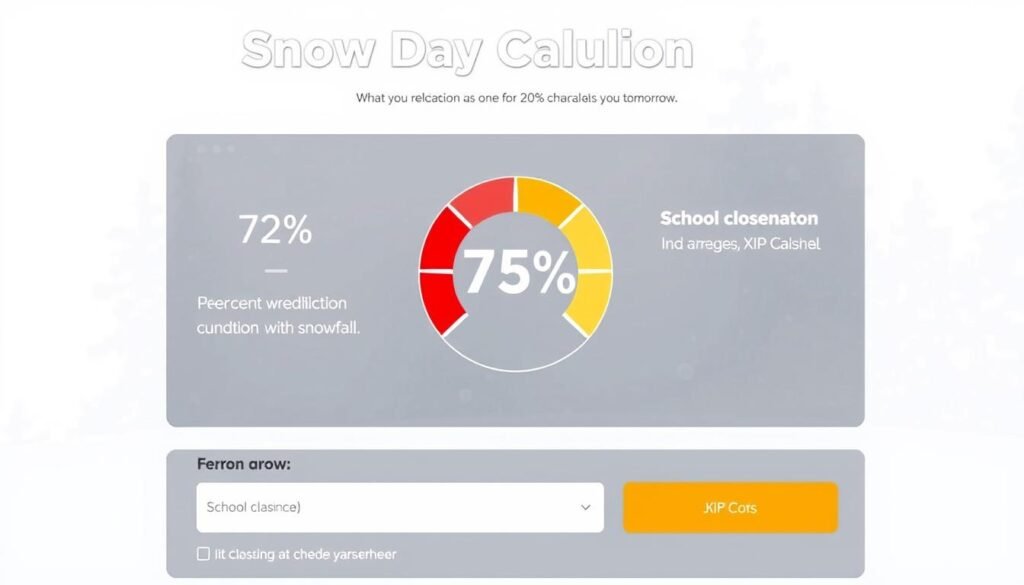
A typical snow day calculator interface showing prediction percentage and weather data
A snow day calculator is an online tool that predicts the likelihood of school closures due to winter weather conditions. Unlike general weather forecasts, these specialized calculators focus specifically on factors that influence school closure decisions.
These tools analyze multiple data points including expected snowfall amounts, temperature, wind chill, ice conditions, and timing of the storm. They then compare this information with historical closure patterns in your specific region to generate a percentage probability of school being canceled.
Most snow day calculators are free to use and require only your location information (typically a ZIP code) to generate predictions. Some more advanced versions may also factor in your school district's specific closure history and policies.
How Snow Day Calculators Work
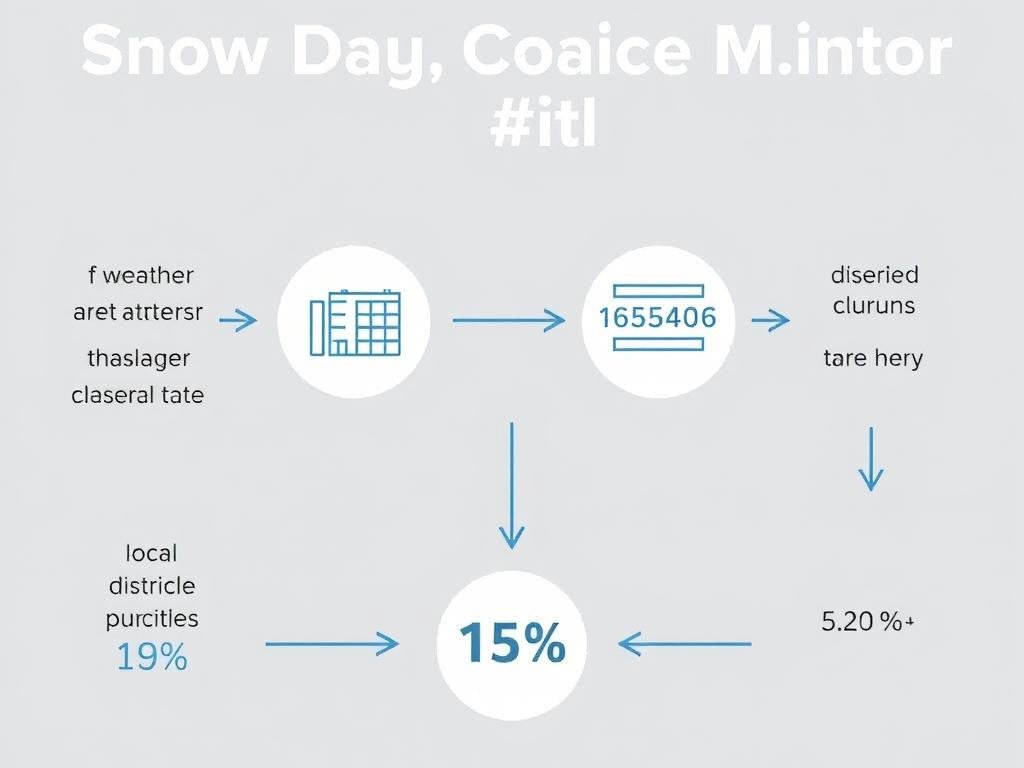
Behind every snow day calculator is a sophisticated algorithm that processes multiple data sources to generate accurate predictions. Understanding these mechanics helps you better interpret the results.
Key Data Inputs
Weather Data
- Predicted snowfall amount (inches/cm)
- Temperature and wind chill factors
- Ice accumulation forecasts
- Visibility conditions
- Storm timing and duration
Regional Factors
- Historical closure patterns
- School district policies
- Local snow removal capabilities
- Geographic considerations
- Previous closures this season
The algorithms assign different weights to these factors based on their historical impact on school closure decisions. For example, the timing of snowfall often matters more than the total amount – six inches overnight before buses run is more likely to cause closures than the same amount falling gradually throughout the school day.
The Calculation Process
- Weather data is collected from meteorological sources
- Local historical closure data is analyzed
- Regional factors are weighted based on importance
- The algorithm calculates closure probability
- Results are presented as a percentage chance
Most calculators update their predictions hourly as new weather data becomes available, making them increasingly accurate as the potential snow day approaches.
Top Snow Day Calculators in 2025
Several snow day prediction tools have emerged as leaders in accuracy and user experience. Here's a comparison of the most popular options available today:

Snow Day Calculator Pro
The original and most widely used snow day predictor, covering all US states and Canadian provinces. Features hourly updates and historical accuracy tracking.
- Coverage: All US & Canada
- Accuracy Rate: 79-84%
- Updates: Hourly
- Special Feature: School district-specific data
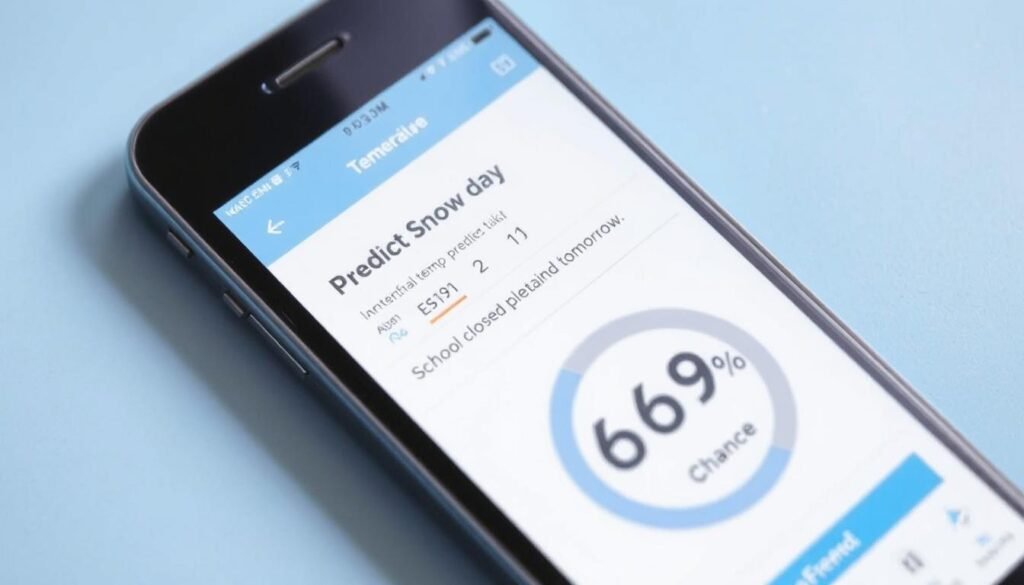
Predict Snow Day
Mobile-focused calculator with push notifications for prediction changes. Offers more detailed breakdowns of contributing weather factors.
- Coverage: US, Canada & parts of Europe
- Accuracy Rate: 76-81%
- Updates: Every 3 hours
- Special Feature: Push notifications

Snow Day Forecast
Newer entrant focusing on machine learning algorithms that improve predictions based on past performance in your specific area.
- Coverage: US (expanding to Canada)
- Accuracy Rate: 81-87%
- Updates: Real-time
- Special Feature: AI-powered learning
Check Your Snow Day Probability
Snow Day Calculator
Enter your ZIP code below to check the probability of a snow day in your area tomorrow. Our calculator uses real-time weather data and historical school closure patterns to generate an accurate prediction.
Accuracy and Reliability of Snow Day Calculators
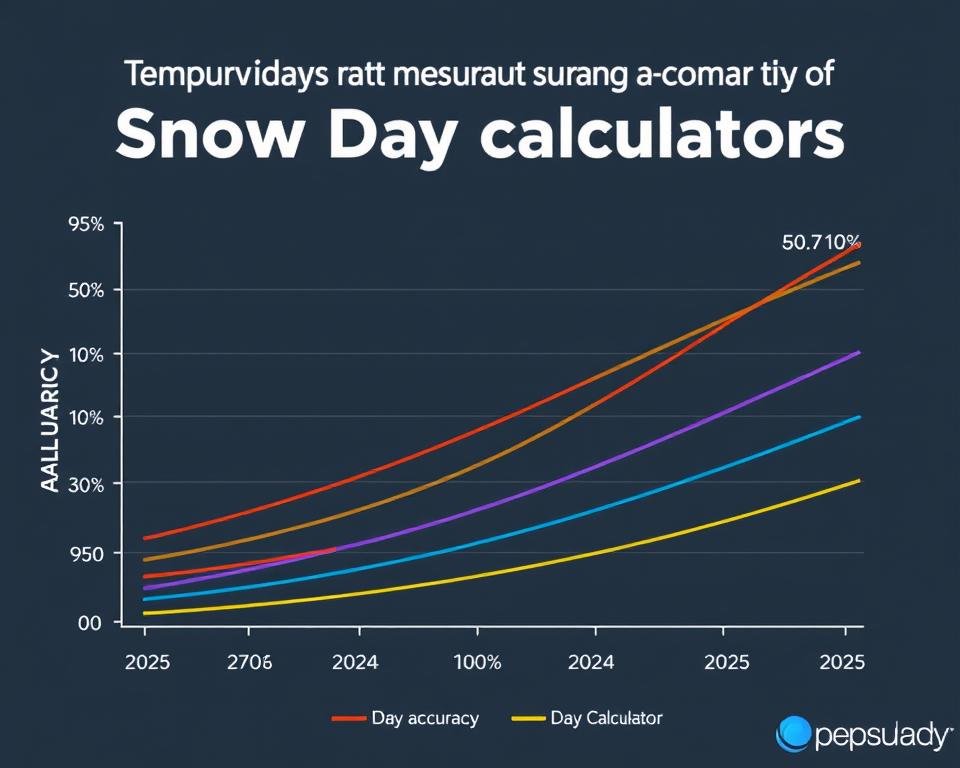
How much can you trust a snow day calculator? While no prediction tool is perfect, the accuracy of these calculators has improved significantly in recent years. Most leading calculators now achieve 75-85% accuracy rates when predictions are made within 24 hours of potential closures.
Factors Affecting Accuracy
What Improves Accuracy
- Proximity to the weather event (within 24 hours)
- Consistent school district policies
- Clear-cut weather conditions (heavy snow vs. light flurries)
- Areas with established winter weather patterns
What Reduces Accuracy
- Rapidly changing weather conditions
- Inconsistent district closure policies
- "Borderline" weather events
- Regions that rarely experience snow
- Mid-day developing storms
Remember: Snow day calculators provide estimates, not guarantees. Always confirm with official school announcements before making important decisions based on these predictions.
The Science Behind School Closure Decisions
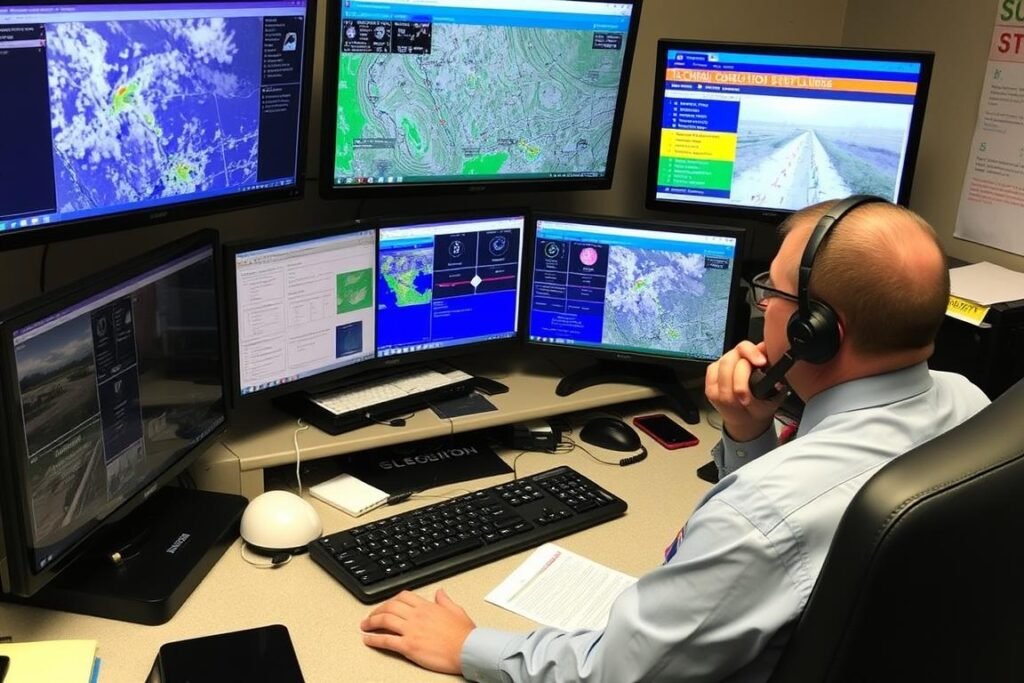
Understanding how school administrators make closure decisions helps explain why snow day calculators work. These decisions follow surprisingly consistent patterns across different regions, allowing algorithms to predict them with increasing accuracy.
Key Decision Factors
| Factor | Weight in Decision | Threshold Examples |
| Road Safety | Very High | Ice present, visibility under 1/4 mile, unplowed main roads |
| Temperature/Wind Chill | High | Below -15°F (-26°C) in many northern districts |
| Snowfall Amount | Medium-High | 6+ inches in northern states, 2+ inches in southern states |
| Timing of Storm | High | Peak snowfall during bus routes (5-8 AM) |
| Forecast Certainty | Medium | National Weather Service warnings vs. advisories |
School districts typically have written policies with specific thresholds for these factors, though they rarely share them publicly. Snow day calculators have reverse-engineered these thresholds by analyzing years of closure decisions against weather data.
Regional Variations
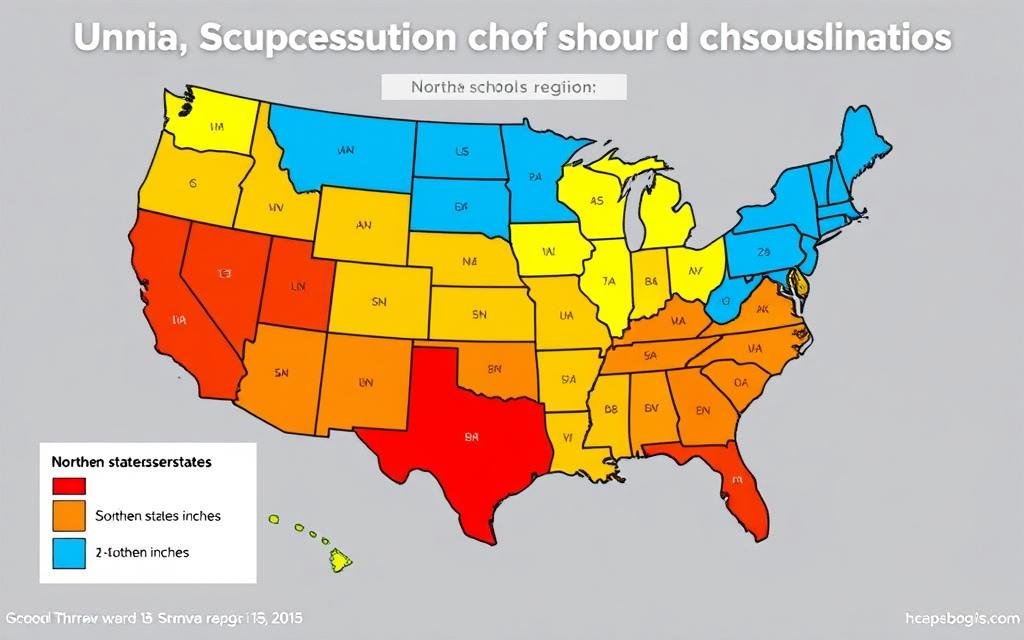
What causes a snow day in Georgia might be a normal winter day in Minnesota. Regional infrastructure, equipment, and experience with winter weather create significant variations in closure thresholds:
- Northern States: Often require 6+ inches of snow, have extensive plowing equipment
- Midwest: Focus on temperature and wind chill as much as snow accumulation
- Southern States: May close with just 1-2 inches due to limited snow removal resources
- Mountain Regions: Consider road accessibility in higher elevations
- Urban vs. Rural: Rural districts close more frequently due to longer bus routes
Historical Context: How School Closure Decisions Evolved

School closure decisions have transformed dramatically over the decades, evolving from simple observation to data-driven processes:
1970s-1980s
Superintendents often made decisions by physically driving district roads at 4-5 AM or relying on basic weather reports and personal judgment.
1990s-2000s
Introduction of more sophisticated weather forecasting, conference calls between districts, and standardized protocols for decision-making.
2010s-Present
Data-driven decisions using advanced weather modeling, road condition sensors, and predictive analytics to make more consistent closure calls.
This evolution toward more systematic, data-driven decisions is precisely what makes snow day calculators increasingly accurate. The same patterns and thresholds that administrators use can be identified and incorporated into prediction algorithms.
The Fun Side of Snow Day Predictions

Beyond their practical value, snow day calculators have become a cultural phenomenon that brings excitement and community engagement to winter weather events.
Snow Day Rituals and Superstitions
Many students combine calculator predictions with traditional "snow day rituals" believed to increase the chances of school cancellation:
- Wearing pajamas inside out
- Placing spoons under pillows
- Flushing ice cubes down toilets
- Sleeping with a white crayon under the bed
- Putting a wooden spoon by the door
- Walking backwards to bed
- Shaking snow globes
- Doing a "snow dance"
- Leaving windows open slightly
Social Media Impact
Snow day predictions have become a social media phenomenon, with students sharing calculator results and creating viral content around potential closures. Many districts now even announce closures via social media, recognizing its reach among students and parents.
"The night before a potential snow day has transformed from watching the local news to checking calculators and sharing predictions online. It's created a new kind of community excitement around winter weather."
Limitations of Snow Day Calculators
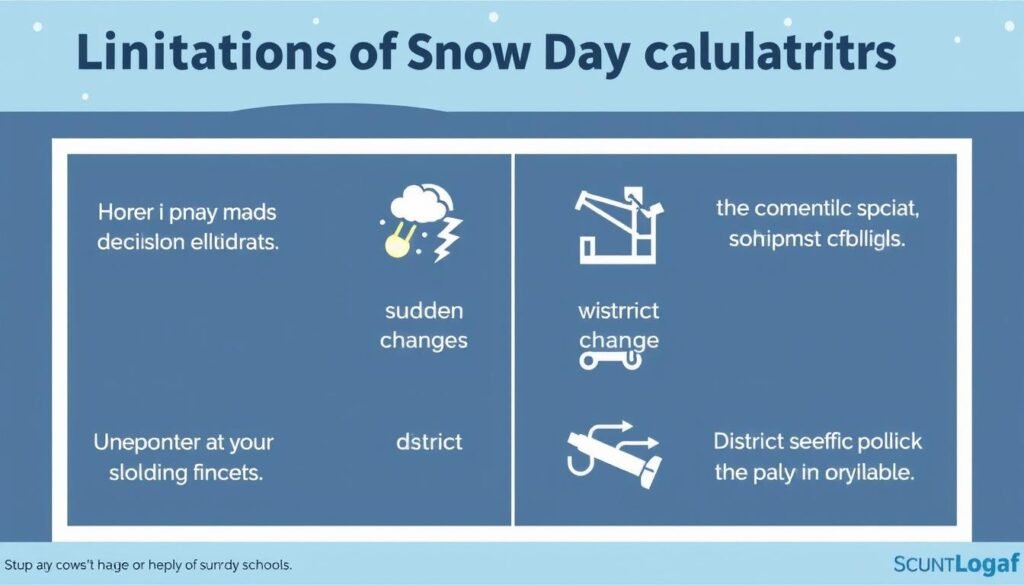
While increasingly sophisticated, snow day calculators still have important limitations users should understand:
What Calculators Do Well
- Process weather forecast data accurately
- Apply historical patterns to new situations
- Account for regional differences
- Update predictions as conditions change
- Provide probability-based estimates
What Calculators Can't Predict
- Last-minute administrative decisions
- Equipment breakdowns (buses, heating)
- Staffing issues affecting schools
- Sudden weather pattern shifts
- Non-weather factors (power outages, etc.)
- District-specific policy changes
Important Note: Always verify predictions with official school announcements. No calculator, regardless of accuracy rate, should replace checking your school district's official communications.
Tips for Using Snow Day Calculators Effectively

Best Practices for Accurate Results
- Check multiple times - Predictions become more accurate as the potential snow day approaches. Check once 48 hours before, again at 24 hours, and a final time the evening before.
- Use your exact location - Enter your precise ZIP code, not a nearby city, as conditions can vary significantly even within small areas.
- Compare multiple calculators - Different tools use different algorithms. When multiple calculators show high probabilities, confidence increases.
- Verify with weather sources - Cross-reference calculator predictions with National Weather Service forecasts and local meteorologists.
- Consider your specific school - Some districts are more conservative than others. Factor in your school's history of closure decisions.
Red Flags for Inaccurate Predictions
- Dramatically different predictions between calculators
- Predictions that don't change despite updated weather forecasts
- Very high predictions (90%+) more than 48 hours in advance
- Calculators that don't ask for location-specific information
Never Miss a Snow Day Again
Sign up for automatic snow day alerts delivered straight to your phone whenever the prediction for your school exceeds 70%.
The Future of Snow Day Prediction Technology

Snow day prediction technology continues to evolve rapidly. Here are the key developments we can expect in the coming years:
Emerging Technologies
AI & Machine Learning
Advanced algorithms that learn from each closure decision to improve future predictions, adapting to changing district policies and climate patterns.
Hyper-Local Forecasting
Micro-climate modeling that can predict conditions down to individual school campuses rather than broad ZIP code areas.
District Integration
Direct data sharing between school districts and prediction tools, incorporating actual decision thresholds used by administrators.
Beyond Snow Days
The technology is expanding beyond just snow to predict other weather-related disruptions:
- Heat days (school closures due to excessive heat)
- Air quality closures
- Flood and severe weather predictions
- Virtual learning day predictions
As climate change creates more variable and extreme weather patterns, these prediction tools will become increasingly valuable for school communities planning around weather disruptions.
Conclusion: Are Snow Day Calculators Worth Using?
Snow day calculators have evolved from novelty tools to surprisingly accurate prediction systems that provide genuine value to students, parents, and educators. While they can't guarantee results with 100% certainty, the best calculators now offer reliability rates of 75-85% when used properly.
For families and educators in snow-prone regions, these tools offer a practical way to prepare for potential disruptions, reducing the morning scramble when closures occur. They've also added a new dimension of fun and anticipation to winter weather events.
As with any prediction tool, snow day calculators work best when used as one part of a broader information strategy – check the calculator, but also verify with official sources and local weather reports. When used this way, they're definitely worth incorporating into your winter weather routine.
Ready to Try a Snow Day Calculator?
Enter your ZIP code to get an instant prediction for your area, or explore our comparison of the top calculators to find the best option for your needs.